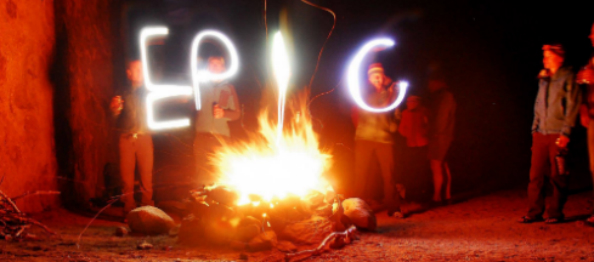Posts Tagged ‘mt. whitney’
February 8th, 2019
“You get what you get and you don’t throw a fit.”
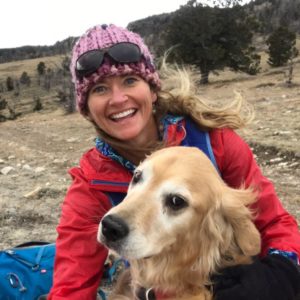
Howdy!
These were the words of a family friend, and former neighbor Bruce Thoren. He had said it years ago when our families were sharing a llama hiking adventure and there were one million mosquitoes (per hour) swarming around us.
I’ve never forgotten the wonderful adventure or the quote.
I’m a voracious reader and an avid quote collector. I never forget quotes that inspire and impact me. You’re going to read a few of them in this post.
For almost a decade now, I’ve reserved Fridays for long solo hikes or snowshoe or ski outings. Unless I’m traveling or injured or under the gun with work deadlines or call volume, I have honored this standing date. These solo treks are so valuable to me. They provide me with time for contemplation, brainstorming, and sorting out emotional or mental challenges I’m having. Of course, they also provide for improved fitness and endurance, which are important to me given my personal interests, and the fact I need to stay in top shape to lead clients on Epic Adventures.
The reason I’m writing about this today is that it’s Friday. I had plans to skate ski this morning. I had limited time compared to normal so I planned to ski in town at the golf course.
It was –5 degrees. Oh, how I did not want to ski! I didn’t want to even leave the house when I learned the temperature. (Sometimes, in this day and age, I think we can have too much information. This morning it may have been helpful for me not be able to know the actual temperature. But I digress… )
In addition to having to confront subzero temps, I was feeling stiff and sore from a workout I did on Wednesday. The thought of going out and doing one of the most physical activities there is to do, and to do it in subzero temperatures, with stiff and sore muscles, well, let’s just say I wasn’t exactly eager. But then, as if right on cue, I caught myself saying to myself, “You get what you get, and you don’t throw a fit.”
And with that, I was in the car headed to ski. (Thanks Bruce.)
By the way, one benefit of subzero temperatures is you will likely get to enjoy first tracks, and you’ll probably have the trails all to yourself. This morning I enjoyed both, thank you. 🙂
My skis barely glided on the squeaky corduroy. My face was frozen, and I couldn’t feel my fingers or toes or ears. The clouds were unusual and looked as if they had a blurry outline to them. I couldn’t discern if my vision was blurry due to the tears in my eyes from the frigid cold, or if the clouds actually looked like they had a blurry outline. (See photo.)
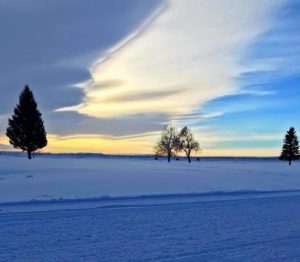
Cool cloud formation during subzero temperatures this morning.
Eventually, and thankfully, the sun came out. It wasn’t any warmer, but the bright sun’s presence lifted me psychologically. And I got a heck of a workout in.
By the way, no one ever regrets that they did what they said would do. And no one ever regrets working out. It’s good to remember these things when we are struggling to keep our personal health commitments.
I can’t tell you how many Fridays during the last 10 years that the weather and/or trail conditions were unfavorable, but the number is significant.
Of course, I prefer blue skies. Nothing says possibility like blue skies. As an adventurer and an adventure guide, I love a favorable forecast and blue skies, and thanks to living in Lander, Wyoming, I get those things often. But there are still plenty of times when I don’t.
It has been during the many Fridays of unfavorable, unpredictable and uncomfortable conditions when I have experienced some of the best training of my life. And I’m not talking about the physical training.
Due to so much training in unfavorable conditions, I have more experience with uncertainty and adversity. The emotions one experiences when in uncertainty or adversity, regardless of the context, are the same. So going out and having to weather the elements, make decisions, mitigate risk, and manage our morale in uncertain and/or adverse conditions, while somehow remaining optimistic, provides great practice and training for all aspects of one’s life.
A handful of years ago, I led a co-ed Mt. Whitney Epic Adventure. I never worked so hard, by myself or while leading a group, to climb a mountain while never actually climbing it.
The morning we embarked on our expedition, as we left for the trailhead, one of the guides I was partnering with to provide the Mt. Whitney Epic Adventure, told us: “Let us remember: The journey is for the soul. The summit is for the ego.”
I thought to myself, What a fantastic quote, and I’d still like to get us a summit…
The weather forecast warned us of an incoming storm, but it was hard to believe the forecast given the conditions on our first day. During our hike to the first camp, we enjoyed clear, blue skies and warm, bright sunshine. However, weather forecasters were correct. By Day 2, we experienced freezing temperatures, and a windchill of –13, and during the night, our tents were buried by snow. When we woke up the next morning, small icicles were hanging from our tent’s interior.
One of the members of the expedition, who is a dear friend, had a migraine due to the dramatic shift in weather from the sunny and blue sky one day to the aforementioned adverse conditions. And if that wasn’t enough, her contacts actually stuck to her eyeballs during the night of the storm. (Excuse my language but this dear friend is a total badass.)
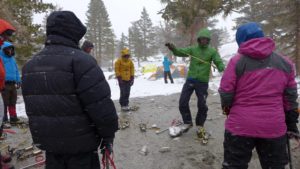
A photo from my 2014 Epic Mt. Whitney expedition, the mountain climbing expedition where we didn’t climb a mountain.
We made the best of it, but in the end, we didn’t come close to climbing Mt. Whitney.
While I was–we all were–disappointed that we couldn’t stand on the top of Mt. Whitney, I developed my leadership more in that single experience than I did on any previous expedition. And there had been many previous expeditions.
By the way, success is a curious thing, isn’t it? It’s interesting that we consider an expedition where we stand on the summit a success, and one where we don’t as not a success. Of course, I know better, but you get the point. We attach success to our hopes and expectations, which if you think about it, is limiting because anything less than that is then automatically considered not a success (failure).
For the record, I would not wish to relive the snowy and cold and exceptionally challenging Mt. Whitney expedition. But I would not trade the experience for anything. The hard experience developed me further as a leader. I still reflect on things I learned, and things I’d do differently as a leader, thanks to that challenging experience when the conditions were so unfavorable. I learned a lot from the guides, and their leadership styles amidst adverse conditions. I learned a lot about managing the risks, and morale, of a challenging expedition.
My previous Mt. Whitney expedition had gone exactly as planned. We had perfect weather every day and enjoyed a long celebration on the mountain’s summit. It was an incredible experience, but did it develop me as a person or a leader? Probably not very much.
The journey is for the soul. The summit is for the ego.
I know it’s cliche, but life is a journey. If we are too focused on our dreams and the end goals–”the summit”–we risk missing out on the experiences of life, the numerous small things that add up to make a good and unforgettable life.
Another favorite quote is from Josh Waitzkin. Waitzkin is an American chess player, martial arts competitor, and author. As a child, he was recognized as a prodigy and won the U.S. Junior Chess championship in 1993 and 1994. The film, Searching for Bobby Fischer, is based on Waitzkin’s early life. (If you haven’t read his book, The Art of Learning, I highly recommend it.)
Waitzkin said something in a conversation with Tim Ferriss over a year ago that I recall often. Waitzkin was explaining about the earliest years of his son Jack’s life, and how “bad” weather could have so easily negatively impacted them if they had let it.
“One of the biggest mistakes that I observed in the first year or two of Jack’s life that I observed with parents is that they have this language around weather; weather being good or bad. Whenever it was raining, they’d be like, It’s bad weather. You’d hear moms, babysitters, dads talk about if it’s bad weather, we can’t go out or if it’s good weather, we can go out. So that means that somehow we’re externally reliant on conditions being perfect in order to be able to go out and have a good time… I don’t think we’ve missed one storm… Rain or snow, going outside and romping in it. We developed this language around how beautiful it was. So now whenever there’s a rainy day, Jack says, ‘Look, Da-Da. It’s such a beautiful rainy day.’ And we go out and we play in it.”
I love that story and the important lesson it captures. It does a beautiful job of making the point I’m trying to make with this blog post, which is, the weather is only bad if we decide it is. Or, our life sucks only if we say it does. (Or, suck it up, buttercup. Or, any day outside beats doing laundry. Or, life isn’t perfect. Etc. :))
I’m almost done here, but I have one more thing I just can’t resist sharing.
I once interviewed my friend, and one of Lander’s beloved human beings, Debra East. I was interviewing Debra about her fitness goals and training program. I captured the interview at the swimming pool, right after Debra’s morning swim workout. During the interview, Debra remarked, “I’m not training for any event other than my life.”
Those words of Debra’s are among my favorites of all time.
Hopefully, we are all “training” for our life. Life is, after all, our most important event. And because life is uncertain and full of good times and bad, hardships and celebrations, we ought to look at the hardships, losses, and setbacks not as a bad thing, but as important training.
Why do we so often let ourselves off the hook? We decide we’re going to do something but then when the opportunity comes to do it if the conditions aren’t perfect, we let ourselves off the hook. Even worse, when we let ourselves off the hook, we probably tell ourselves, It’s not that I’m not going to do it. I’m just not going to do it today.
It can be dangerous to think that way because when we are quick to let ourselves off the hook from our commitments, days, or weeks, months, years–a life–can go by and we didn’t do the thing we wanted or needed to do and we can no longer do it.
We ought to wake up each day, and, regardless of what life delivers us, take what we get, learn from it, and not throw a fit.
Thank you so much for stopping by, and for giving of your time to read my thoughts. I appreciate it so much.
May 2nd, 2014
“The summit is for the ego and the journey is for the soul.” (origin unknown)
These were the words of our lead guide, Thomas Greene, of Sierra Mountaineering International, as we wrapped up our gear issue in the parking lot of the Dow Villa Motel in Lone Pine, California.
Mt. Whitney, the tallest mountain in the Lower 48 states, and the mountain we had come to climb, loomed in the background.
I loved Thomas’s quote, and vowed to remember it for a future time when it would come in handy, such as in a speaking presentation, or during a future coaching session. At the moment, its relevance eluded me.
Months earlier, I began assembling a group of intrepid men and women to embark on a Mt. Whitney mountaineering trip. It marked the first co-ed epic adventure for Epic Life. Leann, Karla, Chuck, Helen, Craig, Cutter, Grant, Jackie, Jenni and Sonja came from near and far to climb the mountain.
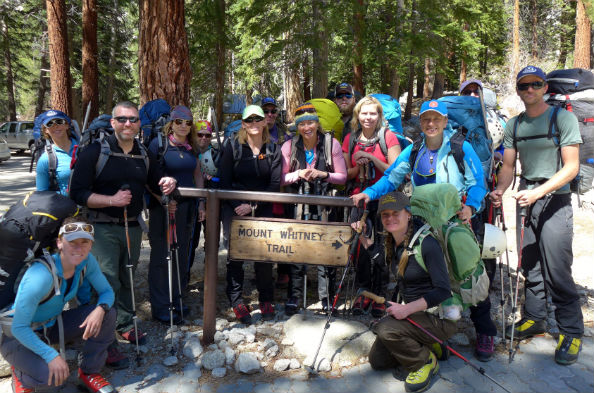
Group photo at the start.
Our backpacks loaded, we convoyed to the Whitney Portal trailhead, and started up the trail. Our plan (Plan A) was to hike to Lower Boy Scout Lake for the first night, then on Day 2, advance to High Camp, from which we’d make our summit bid, and at which we’d spend 2 nights.
The first mile is a nice, well-used trail, and as is typical, and wonderful, the members of the group started conversing and discovering more about each other. At the one-mile mark, we refilled our water bottles from a creek, and received some lessons from the guides about pressure breathing, and the “rest step,” both of which would be useful during our mountaineering adventure.
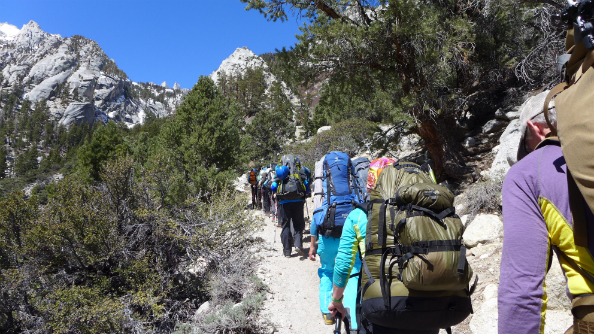
Enjoying the first – and easy – mile of the adventure.
At this point, we left the hikers’ trail and started what is commonly referred to as the Mountaineers’ Route. We hiked over a rough trail and through some deep-and-soft snow. At times, a leg would post-hole to the knee or lower thigh. Otherwise, so far so good. The day was a stellar one. Bluebird sky, chirping birds and inspiring scenery.
Next up would be The Ledges. I knew from my experience climbing this mountain last year that The Ledges would be one of the most notable features of Day 1’s backpacking.
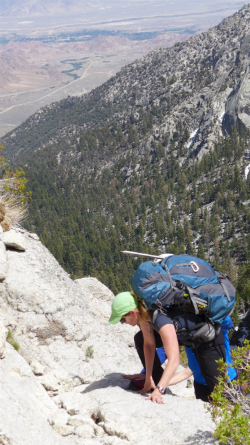
Leann, making her way over one of the ledges.
The Ledges represent a section where we use hands and feet to scale our way up over some cliffs. The “ledges” are narrow, but plenty wide. It is the exposure and what if’s that make it exhilarating. Our mind wouldn’t be free while scaling the ledges. We’d need to be focused in order to stay safe. Other than that, The Ledges are a blast to ascend, and I knew that the members of our group would either love them or at the very least, find them memorable.
From The Ledges, we continued up a pretty steep trail. One of our guides, Zach, stopped us to point out a “lenticular” cloud that we could spy over the tall granite mountains ahead of us. He said something to the effect of “That means change is coming.”
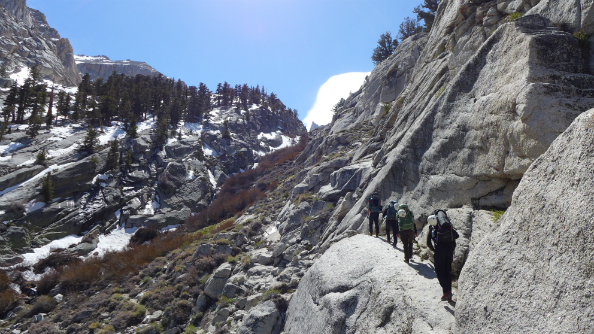
Hiking toward Low Camp. Note the lenticular cloud ahead and over the tall granite mountains we were heading for.
We were all aware that the weather forecast for our four days was not ideal. It called for “unsettled” weather, including an 80 percent chance of snow, and high winds for Day 2, and into the morning of Day 3. We weren’t thrilled about this, but we also knew that the weather in the high Sierras is highly variable and that the forecast could be wrong. As we made our way toward Mt. Whitney, I was hoping the forecast would shift in our favor.
By mid afternoon, we arrived at Lower Boy Scout Lake, which would be our home until the next day. We set up our tents, and got ready for a demonstration of a very important skill required on a Mt. Whitney mountaineering adventure – How to Poop in a Bag.
“Wag Bags” are a requirement if you want to climb Mt. Whitney. And, although this is something many cannot fathom doing, can you imagine if it weren’t a rule and people could just go #2 anywhere? The result would be unacceptable and awful for all kinds of reasons that you can surely imagine. So, we dispose of our human waste in a bag…
As I handed off the teaching of this skill to the guides, I emphasized to the group, “Trust me, if you can poop in a bag, you can climb any tall mountain. (And, no, this would not be a live demonstration!)”
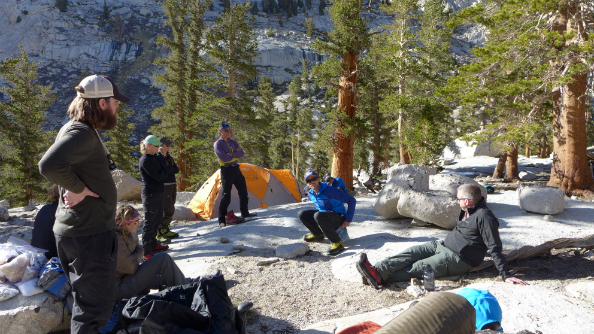
Guide Zach demonstrating how to use a wag bag.
I wish I would have captured photos of the looks on some of the members’ faces as they learned how to manage bowel movements in the high country, but I didn’t. Next we enjoyed some soup and hot beverages before snarfing our dinner – epic burritos with extra beans. (Just kidding!)
Our camp site was extraordinary. The evening was cold, but clear and beautiful. And even though I live in the Wind River mountains, which are in many ways similar to the Sierras, including the fact that the weather can change in an instant, I found it hard to believe that our stellar conditions were about to change so dramatically.
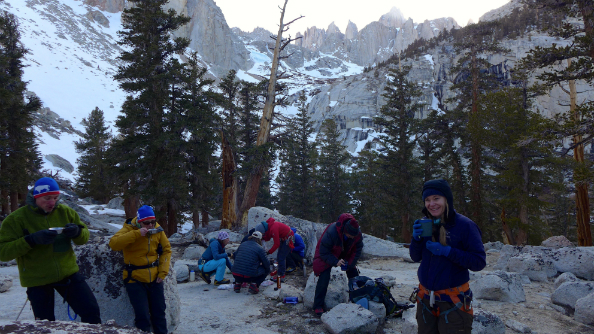
Our first evening at camp was a little chilly, but otherwise amazing, complete with great company, a clear sky, extraordinary scenery.
I awoke early the next morning, and walked to the back of our camp to get a look at where we had come from the day earlier. I was greeted by a breathtaking sunrise. Despite the unfavorable forecast for the hours ahead, the sunrise gave me hope.
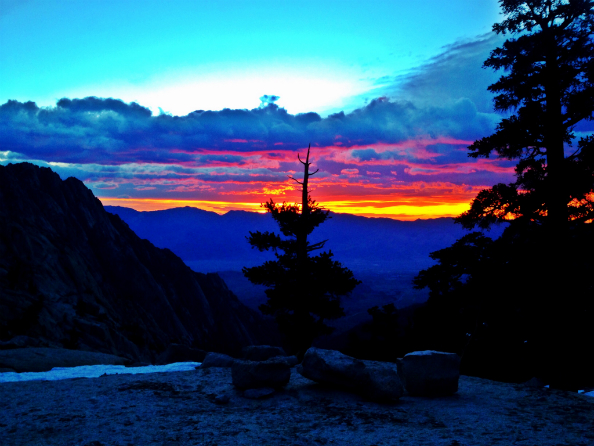
This is the sunrise I was greeted with on the morning of Day 2.
By breakfast time, it was obvious from the weather that our Plan A was out. By 9am, as Mt. Whitney and the surrounding peaks started to go behind a white curtain, we started battening down the hatches, and our plans to advance to High Camp faded.
When I coach my clients, I often challenge them to consider the question, “What if Plan A doesn’t work out?” I value this question, and use it in my own life on many occasions. The value of doing so lies in the fact that Plan A often does not pan out, and it’s better to have a Plan B than to give up if Plan A doesn’t work. In fact, I’ve had some Plan B’s that turned out better than my Plan A could have possibly turned out.
Nevertheless, as Thomas and the guides explained the dangers of advancing, setting up camp, and living exposed at 12,000′ in gale force winds and a blizzard for the next 24-plus-hours, I silently cursed the Universe for driving home this point about Plan A not always working out, which, for the record, I already was well practiced in.
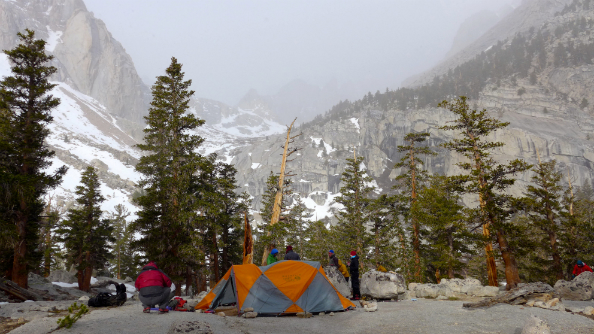
Mt. Whitney and surrounding peaks became less visible at start of Day 2.
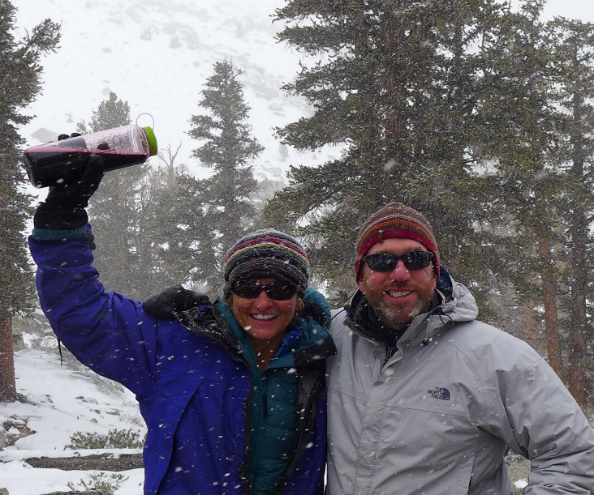
Posing with Grant, and the wine we were not drinking.
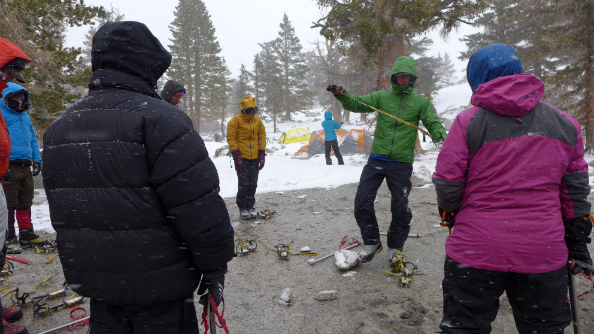
Since we couldn't advance to High Camp, we geared up to practice some skills we would need during our summit attempt.
Our new plan (Plan B) was to hope for a break in the weather in the wee hours of the morning of Day 3 so that we could execute a summit attempt from our current location. It wasn’t ideal; it would make for a very long summit day. But we wanted to climb Mt. Whitney, and what other choice did we have?
As the morning wore on, wind blew through our camp and a blizzard dumped snow upon us. We did the only reasonable thing – we hunkered down in our tents. By early afternoon, though, we wanted out of our tents, so the guides taught us skills that would help us on summit day, including how to use an ice axe as a hiking stick on steep snowy terrain, how to self arrest, and how to hike with crampons on. We went for an uphill crampon hike in blowing snow. It felt good to move, and doing so warmed us.
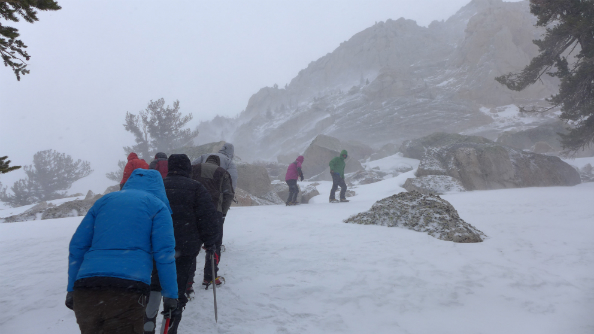
Hiking with crampons on during a blizzard on Day 2.
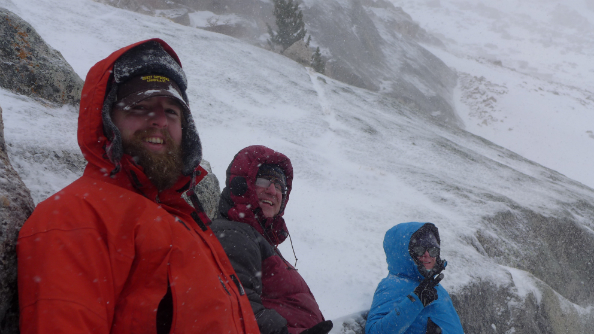
Cutter, Craig and Sonja, being champs during the blizzard.
Upon returning to camp from our hike, I sensed we were all feeling invigorated. We quaffed soup and hot beverages as Thomas instructed us on what we needed to have ready for our summit climb. We ate dinner and tried to be hopeful. The guides indicated that our best case scenario was for the weather to be clear at 2am, at which point we would be awakened, and we’d start our trek to the summit. He added that if the weather didn’t clear in the wee hours of the morning, then we’d hopefully still have a chance, although not an exceptional one, come 6am. (I considered the 6am start our Plan C)
As leader of this group I wanted my people to be comfortable and warm and rested, and I wanted for them to get a shot at Mt. Whitney’s summit.
Based on my experience that night in the tent with Sonja and Leann, as well as feedback shared by members of our group later, Night 2 was “noteworthy” for its challenges. As the one responsible for bringing everyone to this mountain, I was nervous and excited. I was certain I wouldn’t sleep, and the weather made sure I didn’t.
High winds hammered our tents all night long and carried, and dumped, snow on our camp. Every hour or so we’d shake the snow off of our tents. Even though we vented our tents, the snow worked hard to bury us and the result was condensation and water dripping inside our tents. The harsh conditions outside, combined with the restlessness inside, left us feeling uneasy. For my part, I lay there praying for strength, if not for a break in the weather.
Night 2 was a different kind of challenging for others in the group. I won’t name any names, but three people who were sharing a particular tent reported feelings of claustrophobia and unpleasant fumes. It is important to mention that the telling of this story by the aforementioned tent mates gets more humorous with each telling. And one of the members of the tent went as far as to say he is grateful for having had the challenging and unique experience of that night in their tent, because it is something he’ll never forget and will enjoy telling others about for years to come.
Another tent group had what one described as “something close to a slumber party.” We heard them giggling and making a loud request for wine, which I’m quite certain went unanswered. They shared snacks and applied various skin treatments. “Who knew we had the makings of an entire spa in our tent!” said one of that tent’s members when I asked her to recall Night 2.
But we weren’t having a party in our tent. I knew Leann and Sonja weren’t sleeping either. Have I mentioned it was a challenging night? On the upside, for a lack of other things to do, and because we could, we ate a lot of chocolate during the night. A lot, a lot. (File under #NotOurFault)
As I lay there trying to be strong and hopeful, 2am – and our Plan B – came and went. 3 am, 4am and 5am passed. Snow continued to fall and gusts of wind continued to blow. But then, around 6am, as if by a miracle, the snow had stopped falling, and the wind had stopped blowing. At our wake-up, we were greeted by a snow-covered camp and most importantly, a clear, blue sky above. Could our Plan C be possible? I wondered, with optimism.
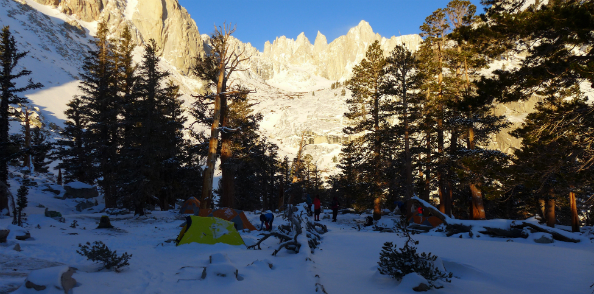
The scene at morning of Day 3. We were snow-covered, but it was a clear and stellar day. A summit attempt, although it would be a hardy one, seemed possible.
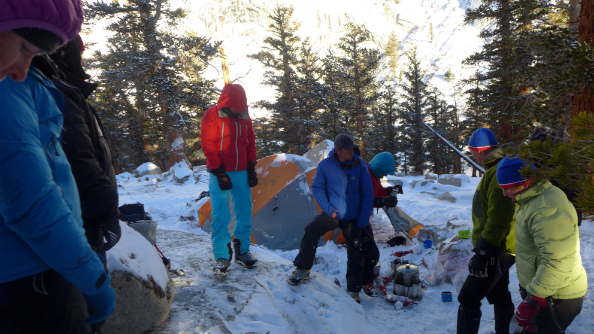
Huddled with the guides, we learned Plan C was off.
It was a cold but spectacularly beautiful morning. Eager for coffee and tea, we huddled around the stove as it boiled our water. Our guides informed us that they hiked a ways above our camp and snow was deep but not problematic. However, the conditions up high were likely unstable, and high wind gusts were predicted up top. Plan C was out.
Our last remaining option (what I will call Plan D) was to not summit Mt. Whitney, but to take an optional uphill hike to Upper Boy Scout Lake, then return to Low Camp, dismantle camp and hike down the mountain. Most of us did that, and it was an amazing excursion. As we hiked up, we passed two parties coming down. Both had attempted alpine starts for the summit, from higher elevations, and were turned around due to unstable snow and avalanche danger. Not that we needed it, but hearing their reports validated our decision to not go for it.
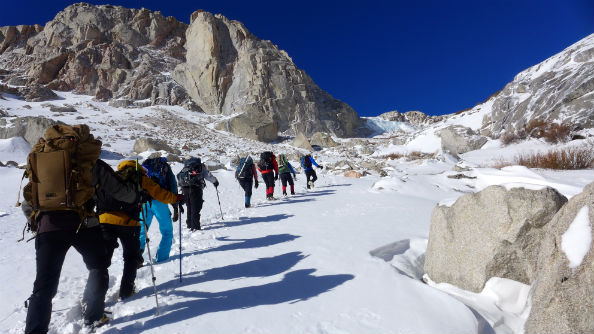
Enjoying a hike toward Mt. Whitney on the morning of Day 3.
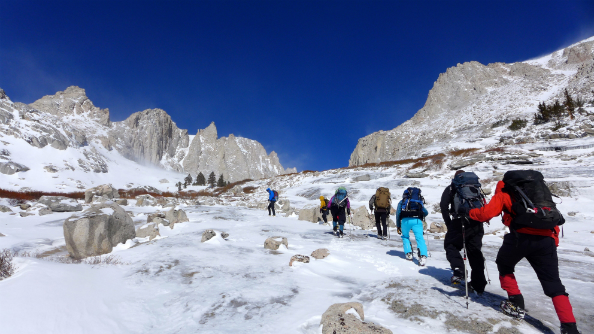
No filter on this sky. I promise it was that blue!
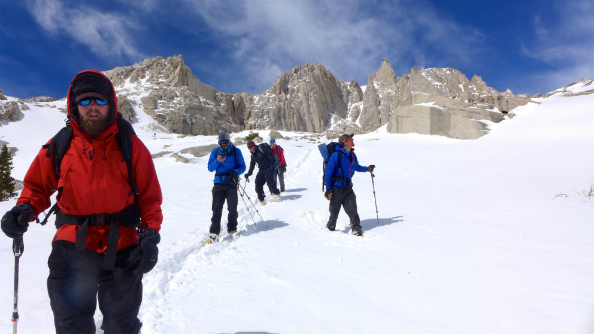
It was fun to get out in some of the snow that dumped on us the day before.
We had a great hike down the mountain under a blue sky before enjoying $5 showers at the Hostel in Lone Pine, some pizzas, beer and wine. We spent our third night camped in the famous, beautiful, and warm, Alabama Hills. We had a huge fire and slept under a star-filled sky. The morning of Day 4 was spent doing some scrambling with fixed lines, followed by a fun rappel – things that were in our original plan.
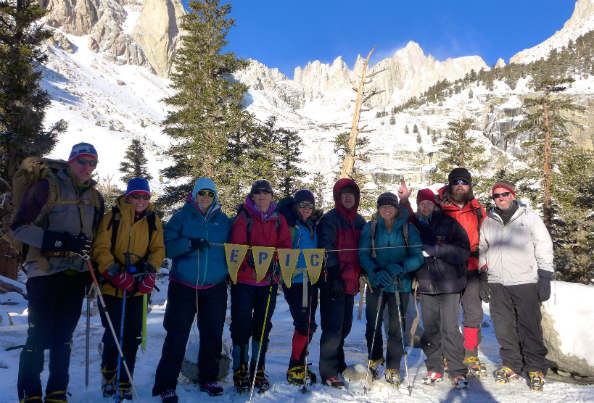
I was honored to share this adventure with an epic group of people. (Helen: I'm sorry you are not in this picture!)
Since our return on April 28, I have found myself reflecting on our Epic Life Mt. Whitney adventure. While we didn’t stand on Mt. Whitney’s summit, we did go mountain climbing.
I wanted our group to stand on Mt. Whitney’s summit and for our group to not risk our lives. We accomplished the most important of those two objectives. For me, the adventure, which provided lessons in leadership and humility, as well as a lot of fun, will remain an unforgettable and amazing memory.
And as someone who climbed to Whitney’s summit one year ago, I have come to the conclusion that not summiting the mountain was more difficult than summiting it, which is ironic. Not summiting due to things we couldn’t control was not only harder to accept, but harder to do. As a result, this year’s unsuccessful summit effort will likely be more informative in my life and work than the successful summit bid in phenomenal weather last year. I wouldn’t trade either experience.
I often remind clients, and audiences I present to, that an epic life is not an easy life. I tell them that an epic life is full of mountains and hills to climb, including those we put there and those we don’t put there but that nevertheless must be climbed, if we are to become actually what we are potentially.
And then, for the first time since the start of our adventure, I remembered the quote Thomas shared at the outset: “The summit is for the ego, the journey is for the soul.”
Indeed.
A special thank you to Leann, Karla, Chuck, Helen, Craig, Cutter, Grant, Jackie, Jenni and Sonja for signing up. Thank you to our awesome guides, Thomas, Lyra, Lindsay and Zach, and to Kurt Wedberg and Sierra Mountaineering International. Thank you to Sonja’s mom and grandparents for their yummy treats and support pre- and post-adventure. And finally, thank you to Jerry (my best half), and to our three sons for their loving support as I develop this business and frequently find myself away from them camped in faraway mountains.
May 5th, 2013
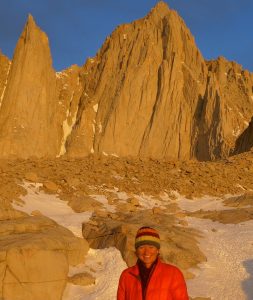
At Mt. Whitney’s high camp.
People don’t hire a life coach so they can keep operating in their comfort zone. Rather, people hire a life coach to dare them to leave their comfort zone. Change cannot be made in the confines of our comfort zone, within the confines of our fears. So we have to dare to explore the edges, to dare to enter a space that is full of uncertainty.
To grow and develop — and follow our bliss — we have to explore the edges of our abilities. We must level up, and I’m so compelled by its value that I’ve built Epic Life around the concept.
Every year I “sign up” for at least one major adventure — what I’ve come to refer to as an Epic Adventure. It could be a hike that covers a greater distance than I’ve ever hiked in a 24-hour period, such as the Rim-to-Rim-to-Rim day hike I did in 2010, or the 50-mile traverse day hike of Zion National Park I did in 2011. Or, it could be climbing the Grand Teton, or Mt. Whitney. Or, many times it’s not outdoors-related at all but it’s still an epic adventure. It could be a proposal or call I make to a high level executive or corporation, or a speaking gig to a high profile audience I dare to accept. For example, we’re about to embark on a 30-day family trip to Europe. Talk about an epic adventures. This is a dream-come-true that is a big financial investment and a lot of time to be a long way from home. We are mostly excited, but nervous too. That is how you know if you’re exploring your edges — it’s something you want to do, and yet it makes you a little, or a lot, uncomfortable.
That said, I do make lots of room for epic outdoor adventures because so much growth happens and in a setting that will inspire me for days and months and years.
In leveling up, at some point during the adventure, I am not enough. I will not have what it takes. This is scary and uncomfortable. This is when I will find myself asking “whose idea was this?” and remember that it was mine. It’s also a powerful point in the adventure because at this crux, I can make a choice: I can quit, or I can continue — learning the skills I need along the way. The adventure becomes a journey of personal discovery as I’m forced to explore the edges of my abilities — to see what I’m made of, and also to discover what’s possible.
If we are to live our best, most epic life, we must dare to live and operate at these edges often.
Living at the edges is not unique to outdoor adventure. Often we are at our edges at home and at work.
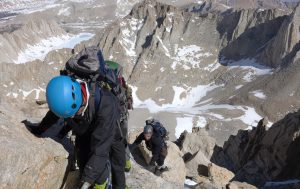
Exposure. Or, scrambling up the last section of Mt. Whitney’s Mountaineering Route.
Think of some of the most nerve-wracking moments you’ve experienced — especially ones that you consciously chose to be a part of. I remember when my friend, Debbie Cohen, chief of people for Mozilla, so generously offered to host a brunch at her San Francisco home for women corporate leaders in her circle so that I could practice my pitch/presentation for Epic Life. I would have been nuts to say no, right, especially given corporate women are my target market. So I said yes. But as the event drew closer, I started negotiating with myself, and looking for a way out. It was all too much. It was too big. What was I thinking? Despite this second-guessing, I hung in there with my commitment to the brunch presentation.
On the morning of the presentation, as women starting arriving at Debbie’s, with about five minutes to go before my presentation was to begin, I retreated to a guest room and became paralyzed in fear. I can experience those emotions of stress and fear by recalling the experience. I was hunched in a chair trying to get myself together, to get “in state.” But instead I was freaking out, nervous and sweating. Hiding, really. I second-guessed myself and my presentation, and Epic Life. “What if these women don’t find what I have to say compelling? What if they’ve heard it before? What if nobody but me cares about what I am here to say?” And so on. Finally, it was time to present, and so I left my hiding place and entered the living room to give my presentation.
The presentation went well and the women were lovely. They provided enthusiastic support for my message and my business, while providing valuable feedback. Even if the presentation were a bomb, the experience of leveling up (raising my game) would have been beneficial in that it caused me to develop new skills and to “cowgirl up.” The experience made me better. And I’m grateful to Debbie, one of the biggest champions of people I know, for giving me the opportunity to rise up.
Just daring to level up is the equivalent of standing on a summit of a mountain. While I love standing on the top of a summit, in my humble opinion, daring to start up the mountain in the first place can be more significant than standing on top of it.
An example of leveling up in my personal life would be the fact that our oldest son, who just turned 13, will be going on a jet, alone, to a junior leadership conference on the East Coast for a week. That will not be easy for my husband and I, and Wolf’s brothers. I will be a mess putting him on a plane. Yet, it will be an amazing experience for our son.
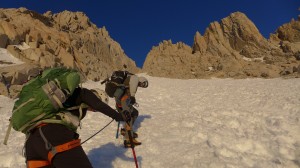
Ascending the couloir, while being short-roped into my summit team.
There are many more experiences like this that I could list. I challenge you to reflect on your own experience of living at your edges.
Regardless of how different our experiences may be, the emotions related to each are the same: fear, stress, anxiety. During these times at our edge(s), we yearn for safety.
Recently, I had the tremendous honor of climbing Mt. Whitney with Backpacker magazine editors and readers who raised a combined $250,000 for Big City Mountaineers, an organization that provides wilderness mentoring and experiences for disadvantaged urban youth. (Thank you to Sierra Mountaineering International for the phenomenal guiding)
It was an amazing opportunity to raise money and climb a mountain for such an important cause. And, sure, climbing Mt. Whitney would be an awesome adventure that would give me another interesting story to tell. But more importantly, the adventure would require me to be at my edges. Frequently. So of course, I said yes when my friend, Jon Dorn, informed me there was available space on Team 4, and invited me.
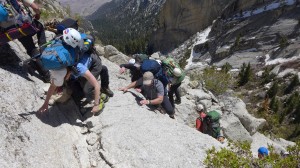
Ascending “The Ledges” on Day 1.
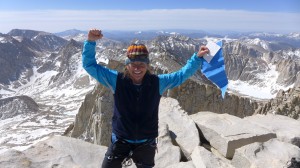
Yeehaw! (On the summit of Mt. Whitney.)
Since returning from the adventure, I have reflected on the many times I was operating at, or beyond my edges during the adventure.
They include:
–Backpacking with 11 strangers. (I knew two of my teammates; the other 11 would be people I would meet in person for the first time) As usual, per these epic adventures, I left Mt. Whitney with many meaningful new friendships.
–Being in unfamiliar country. It would be my first time to the area.
–I had to wear rigid, really warm mountaineering boots. This may not sound daunting to most, but to me, someone who typically hikes in trail-running shoes and who has blister-prone feet, it would be uncomfortable for me.
–The Ledges. On our hike in, shortly after leaving the Mt. Whitney hiking trail, we’d have to ascend “The Ledges,” which were composed of about 400′ of granite slab(s) we’d have to use hands and feet to get up and over.
–Loaded. I would be hiking with a 44-pound backpack on my back. (Normally I hike with 15 pounds on my back)
–”Wag bag.” Alert! (Sorry for the gross nature of this item) This perhaps was the most difficult (uncomfortable) aspect of the entire adventure. We were each given a wag bag at the start, and instructed that during the adventure, “#2” had to be done in the bag — our same bag — and hauled out with us at the end of the adventure. I totally understand and appreciate the need to do this. If it weren’t for the wag bag requirement, the High Sierras around Mt. Whitney would resemble a poop landfill. Still, it is not natural to poop in a bag, over the course of 4 days, and then haul it out. Talk about leaving your comfort zone… By the way, clients and future clients, as far as I know there won’t be any wag bags on Epic Life’s adventures.
–”Self conscious sleeping.” Sonja, one of my two tent-mates, gets credit for this phrase. I, too, would call myself a self conscious sleeper. In a tent with two other women, I worried about snoring or talking in my sleep. As a result, I didn’t sleep very well.
–Ice axe, crampons, helmet, short ropes. These are things I hadn’t used in combination before, and the fact that we’d be using them at all meant the stakes were higher than they are on most of my outdoor excursions. The terrain was steep, frozen in areas, and loose in others. Using all of these tools was a new experience for me.
–”Shitty shit.” This is the term we coined for the loose scree that was on a very narrow and steep couloir that we ascended and descended on summit day. One thing that hiking on the scree reminded me of is that even if you take your steps very deliberately, it’s still possible the entire earth below your feet will give way. It’s the same in life when we dare to go off-trail, or/and higher.
–Class 3 & 4 climbing. The last “obstacle” to Whitney’s summit was a 400′ foot rock climb/scramble. While this section was not that difficult for me, personally, the exposure was significant, and therefore left me feeling apprehensive.
All of the above were opportunities to practice being uncomfortable, to practice leaning in and daring to go beyond my comfort zone. The result of doing so is self discovery. I return more, and better, than I was before.
What is an edge you want to be dared to explore?
(I want to give a special thanks to Jerry and our sons for their continued love and support, and to all of my family and inner circle of friends, to Jon Dorn, and also to Debbie Cohen and Kate Roeske-Zummer for daring me — and to all of my family, friends, colleagues and clients, who make me better, and who generously donated to the Mt. Whitney climb! Also, thanks to Mike Lilygren and NOLS, who helped me “gear up” for the adventure. THANK YOU!)
- Categories: Adventure, Life and Leadership, Travel
- Tags: Adventure, challenge, comfort zone, epic, fear, growth, leveling up, mt. whitney, summit
- Comments: 5 Comments
March 25th, 2013
I’m climbing Mt. Whitney, the tallest mountain in the Lower 48, in less than a month. Sure, it will be epic and unforgettable, and all that. But that’s not why I’m doing it.
I thank you in advance for watching this short video, and for considering helping me climb Mt. Whitney. You can also learn more about the climb, and my reasons for doing it here.






















